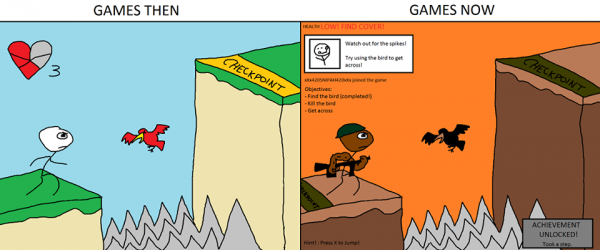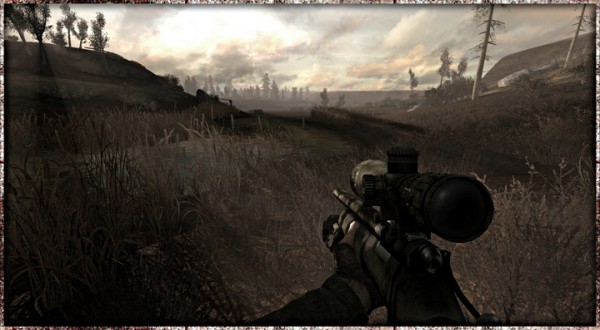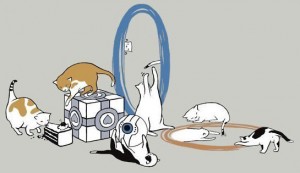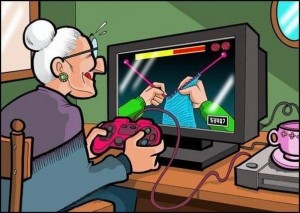| Home » Articles » >> Game Development » General Theory |
(manifest and popular science article)  Short introduction: What is a “Interactivography“, why so called and from where this name? - I myself, the author of this term, being scientist theoretician and game designer, am also a big fan of games and even personally try to create something in this area. When I first became acquainted with the term “Interactive Art”, which represents the art of games I realized that with not too concrete name, it would be too little justice to such a grand forms of contemporary art and an extensive field of culture. So I set myself a goal to find a more appropriate and logical name, from the point of view of science. Being familiar with this area, I have analyzed different variations until finally reached a concrete term, which would be more correctly signified this art, from its foundation (so to say from the origins) and able to open up inside the given phenomenon – interactivography.. The formulation: Interactivográphy (latin: inter - between, activitas - activity, graphica - graphics) is a synthetic form of art on the basis of a computer program, consisting of graphic images, either moving or still, in 2D or 3D dimension, in which the user by with a specific interface and manipulators can interact with the virtual objects, thereby participating personnaly in the actions from games. As is known, the product of interactivographic art is the “Game” (Игра, Juego, Jeu etc.), and her user – called “Gamer” or “Player” (Игрок, Joueur, Jucător etc.).
In details: “Interactivography” (in romanian, my native language – interactivografia), also named “interactive art”, known as an art in which the player is usually involved in some simulations or virtual interactive events, which has unprecedented opportunity to participate as a virtual actor to conduct the artistic or documentary subject of the game. In some games, the user can with its actions to slightly open their story, even conduct the story in his own interests, while having the opportunity to repeat the same action several times. Well, in some modern games the user can come to that final, which will depend on his personal actions throughout the game. To put it simply, in the modern game, each player can participate in the various imitations of actions, that are inspired from real life or to participate in the invented actions, which can be “clothed” in a story (fiction or not ), and where you can feel in the skin of a virtual character by participating in the events of the game as witness or even as an actor in the main role. It’s like playing in the theater at the same scene, not knowing the words and story, but gradually learn every thing personally, intervene whenever we want, and can even change the final in our favor. Respectively being the synthetic art (composite) the interactivography is like a theater where we are playing as actors, and even filmed on a virtual cinema studio. Also in the games we can dance, sing, listen to music, to build as architects, draw, etc., to admire beautiful and high art, or simply fooling around and wander. -)) Still, Interactivography offers us a lot more opportunities than theater or cinematography, constantly evolving, and I even dare say that this relatively new art form, is now the most important to humanity than another form of art!  Brief history, the tangents: Since interactivography is a synthetic art (composite), it also has a lot of common tangents ties (links) with certain forms of art, mostly with the cinematography. For example, in the first decade of the film, some critics and artists have argued that this “new” form of art is just a weak imitation of the theater and not be able for more. But with the advancement of technology, in films appeared sounds and music, colors, even the impression of depth (stereo-vision or the so-called 3D vision), and perhaps in time there will be other sensations, new features and other technical oddities. Now if we look at the brief history of the game, from the first semi digital consoles (what was Pong, Magnavox Odissey, etc.) and to the last generation of consoles and modern personal computers, we can observe the evolution of interactivography at full scale, which is still ongoing. We saw the appearance not only of sounds and colors in games, but also a terrific development schedules, and different manipulators for interactivity. But most importantly, we have seen a terrific product development of interactivography - the games – from simple black and white sports simulators, to as much as artistic or documentary works with budgets of millions, with subjects like in the films and with photo-realistic graphics. Of course, above the interactivographic art hung on a wave of negative criticism from those who do not understand and did not like it, but that does not mean that such criticism will remain in history, but only those who understand this art and adore her. -) Thus, the evolution of interactivography depends a lot on the scientific and technological progress, mainly from the digital computerized technology that offers us not only powerful and more sophisticated equipment, but also new opportunities for interaction in virtual worlds. In addition, some cinematic techniques are widely used in games such as video scenes filmed live (or documentary with actors), or with the help of virtual cameras filming inside the games themselves – the so-called “cut scenes” (also “cinematic sequences”). The interactivographic genres are also identical genres of cinema and theater, even if some people think that in games is more genres. In fact, the “big” number of these genres are dictated by the methods of interactions (that is interactive methods) in virtual worlds. I would not list all these interactive genres, I will highlight just a few of them: - For example, if a player can take a gun in his hand and shoot, then this genre is called “shooter“. If we can drive a car, then this genre -”racing” or “driving simulator“, but if we take the sword and go through it the whole game, this interactive genre will be called “slasher“. Can give the example of many such interactive genres and sub-genres, but nothing in the world is no substitute the artistic genres, though few in number, such as – comedy, tragedy, drama, melodrama – they are still the basis for any artistic work of cinematography, theater or interactivography.  Now if you ask “why the term Interactivográphy is right from a scientific point of view?”, I would say that the answer is simple. – For example, look at what is most important in the art of cinema, what stands at the basis of her – a movement of short fragments of the image to (or from) the video support, forming us the illusion of a general movement of image on the screen to contemplate the film’s action. In the games we primarily interact with the objects of the virtual image on the screen (by acting almost like actors), this interactivity (interaction) being based on computer graphics. Even if this graphics is programmed to interact and also dictated by the program code, though we must remember that the game is just not some multimedia programs or for office work, but primarily represent a modern art form, in which the author (game designer, developer, screenwriter) expresses his artistic vision and philosophy, to the spectator-player reveals the soul, tells him the story and shows the fate of some of the characters. -Is it a simple program?  Perhaps someone might ask, “Well, but what about sports games, with simulations of transport and other things less artistically? Or “games” such as RPG, carried out in real life with real people or paintball competition with shootouts, well, or casino games? What about them?” To this I will answer you, again referring to the analogy: look at the film production. What do they observe? -There are documentaries which tells about the life of certain people, see the history of entire peoples, we see sports with people on the move, or at a different transport, finally, we see a wide variety of events, the elements of life and human history captured on camera and all that “harvested” from the beginning on paper some filmmaker or reporter and woven into a logical sequence of images, which then contemplate on the screen. So it is a complex art of cinematography, composed of artistic films, documentaries (which divided into simple video reports, to serious “documentaries”), filmed on a pre-written scenarios and with real people in the frame (and more recently, even with virtual people). What do we observe in interactivography ? Approximately the same situation – there are works fiction and documentary. These works can be accessed on various digital electronic devices, with one or more players. These works have a graphical interfaces, all based on 2D or 3D graphics and on programming languages. -Do all these digital elements something in common so what happens in real life, in sports, casino and whether those games spent in real life, to be adhered (added) to the interactive art? I have only one answer – No! - Sport, race cars, paintball, casino games, even games RPG, realized in reality (made up separately or inspired from interactivographic games) are separate cultural phenomena. They can only inspire, respectively, can only be a source of inspiration for game developers. As far as the virtual sports, car simulators or other types, these phenomena from the world of digital electronic games can be easily added to interaсtivography as a documentary part of this art. On the other side some elements of virtual sports may represent an artistic interest and value, for example – a graphical interface, game design, and even the methods of interactivity (interaction). Well, if someone thought that I was too unfair to certain phenomena that are very closely related to digital games such as the RPG mentioned above, or card games based on the stories (by the way, who do not know, I confirm that there are such ! ), in the end, these games can be systematized as “analog game” and can be artistic and cultural branches, appeared or inspired from the common areas and form of art – interactivography . It is quite possible that some of these “analog” branches eventually will be able to transform into a separate art form, as his time was with cinematography, arisen from the theater. . Conclusion: It would not be strange, but for some people the games can provide not only an opportunity to try something, what they are not capable in real life, but also a unique sense of wonder and beauty of the real world. In real life, we often do not notice and not admire the world around us, and only when plunge with head in virtual world of the game, then we open our eyes to such phenomena as the movements of arms and legs, the ability to take something or throw, enable, disable, chase, walk, drive a car, fly, etc., light that penetrates through the leaves, the morning fog or dust particles that hover in the sunlight, etc. and so, in some sense re-opening for each of the opportunities and elements of real life, on which we sometimes do not pay attention, and only in the games we see how much are they important and special.  Notes: In science, there are common terms (and scientific, of course) as a phenomenon and an object (it is also thing). So, from a scientific point of view, something in this world can be called the phenomenon, but something the object. For example, football is a phenomenon (sports and cultural), and the ball – an object (with whom you play, of course). So, that in what are you playing, not properly be called a toy, but game . It’s because from a scientific point of view (and rightly so! ), the game is a phenomenon and a toy – it’s an object. Here, for example, such devices known as “PlayStation Portable” or “Nintendo DS” are toys (meaning the objects), well, then what are you playing, using them – this is the games (meaning phenomena). . . . . . . . . . . . . . . . . . . . . . And still - there exist two types of worldviews - objective vision and subjective vision. With the most simple words can be described as follows: some people see the world as it really exists (scientists, business people etc.) – so, have objective vision; others see the world as they wish themselves (religious believers, the majority of philosophers etc.) – so, already have subjective vision.
Me, the author, define myself as a person from the first group. To other people I advise first to identify with their worldview, then you can start something seriously analyze and draw conclusions.  Adequate time for play: We’ve noticed that many of the players too much time devote his favorite games – from 10 hours or more. Some even lose entire days on the game, even without resting. I recall one fatal case when one avid player died after several days of continuous play, without rest. What he had played does not matter. The problem is that this player generally was completely absent of a normal education regarding the playing time, the rest time, regarding the physical and mental health, neither of personal life. On this theme appears an elementary question: How much time should be given for the game? I paraphrase a bit: How much time is normal to play? I personally (the author of this article), being an inveterate player, I came to a conclusion a long time ago about this theme and I’ve already answered to myself on this question, which is wrenching for some. My recommendations are:
So this is the normal time of play – from 2 to 8 hours per day, depending on the circumstances. Even recommend to play more often, but spending for this occupation a suitable amount of time! And it always will charge you with a positive and constructive energy, reduce the stress, a bit detaches from routine, helping to even see its own problems in a different light on the way to solving them, will help you prepare for serious projects or intensive work. And it is not a joke, but is quite serious. Memorize, please:
Be careful, please, because health is very valuable, besides, nature gives us life only once. It is understandable that if you lose your life and health, then you will lose the opportunity to play a lot of games which appear throughout. -) Memorize how many hours is normal to you for playing, and this time it will work in your favor!
 Addition to notes: Yes, by the way! Some outside observers negatively criticize the games for the fact that many zealous players forget about their health and fully devote themselves to the game, as well as commit evil acts, which are seen in some games. My answer to you: and which is the blame of the games!? As if in the world is not enough fans of any series and scary movies, any (stupid or not) TV shows? And these fans are ready all night watch the TV set and to guzzle popcorn with sandwiches, filling their body and soul whit any muck. Amateurs to spend their time in vain and to the detriment of their health there will be anytime, anywhere and does not depend from the form of art, the products of which they “consume”. Everything consists in the man himself, in his family and in society, the product of which he himself is. If anyone of people it does not instilled a sense of proportion, knowledge and sense of caring about their health, tolerance and respect for people, then this is the problem of as this person, and the society in which he lives. And let not implicate in their problem and the forms of art, and let them explain humanly, normal and logical, let them learn how to live with a measure to everything, with taking care of himself and loved ones! - Play, enjoy, live full and do not forget about measure! . . . . . . . . . . . . . . . . . . . . . The author – Dmitry Ghervas (scientist theoretician, game designer, writer, graphic designer) Twitter: https://twitter.com/DmitryGhervas GameDevMasters: http://gamedevmasters.com/dmitrygh GameTalents: http://www.gameplaytalents.com./talents/d Facebook group “Interactivography – the art of games”: https://www.facebook.com/groups/interact
 | |
| Views: 1414 | | |
| Total comments: 0 | |
